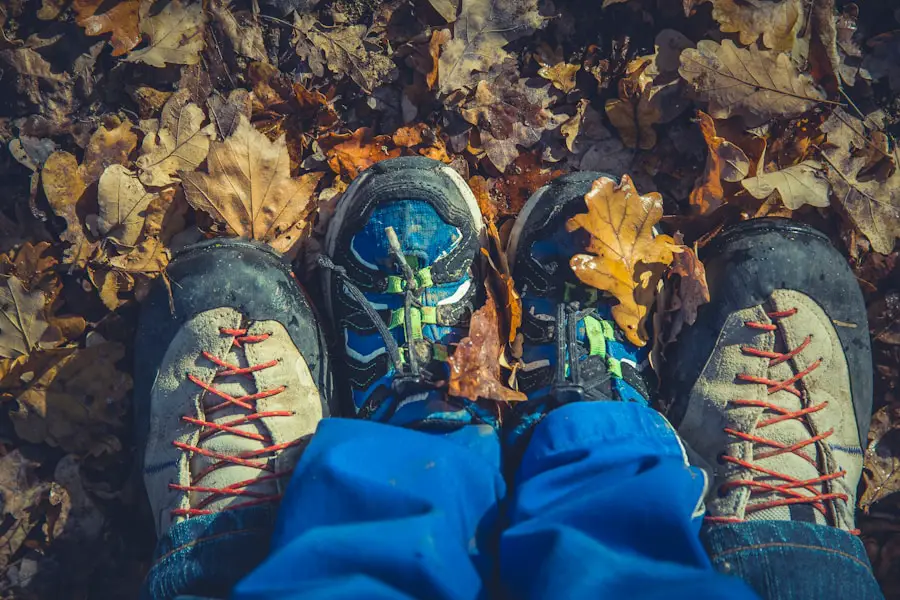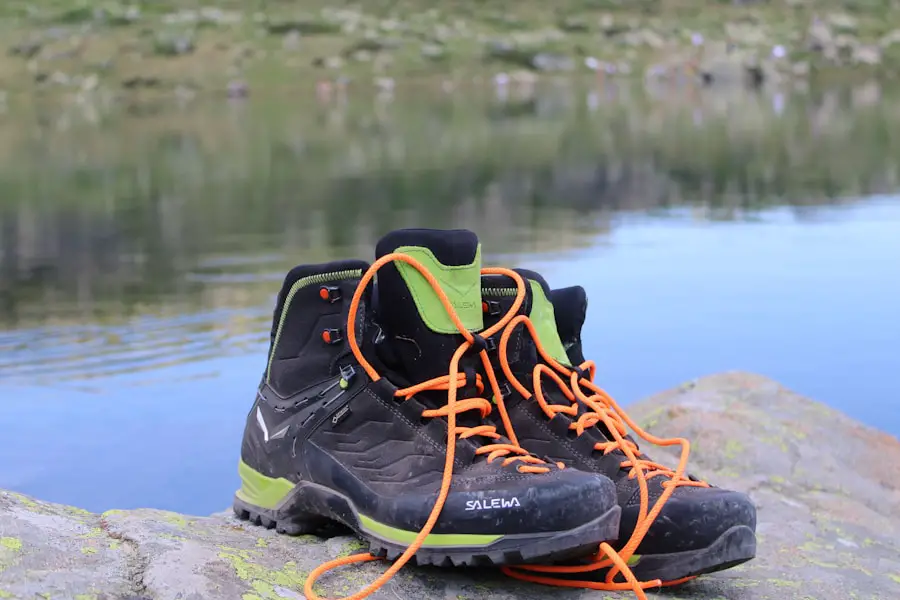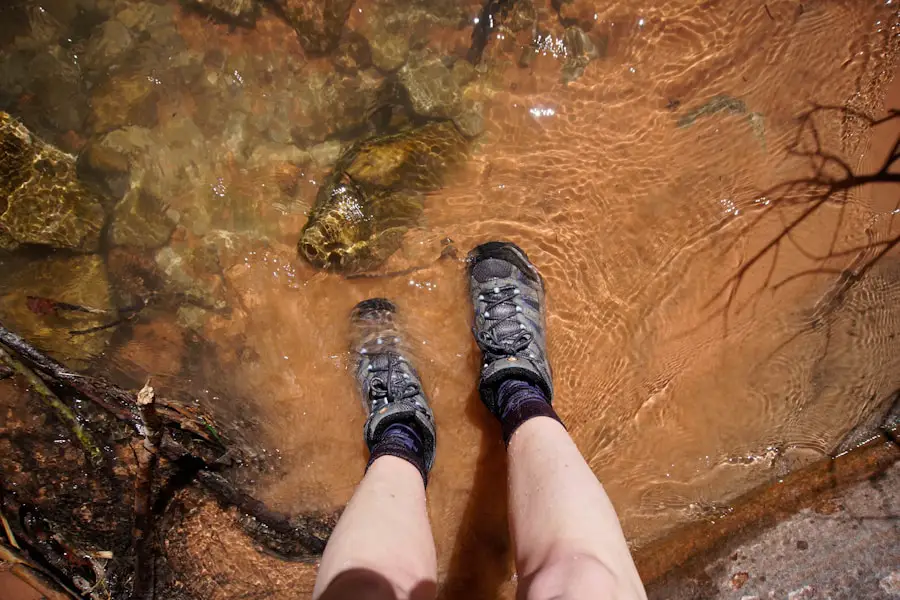Hiking shoes are essential gear for outdoor enthusiasts, providing the necessary support and traction to navigate various terrains. However, the importance of maintaining these shoes goes beyond mere aesthetics. Regular cleaning is crucial for preserving the integrity of the materials, ensuring optimal performance, and extending the lifespan of the footwear.
When dirt, mud, and other debris accumulate on hiking shoes, they can lead to a range of issues, including decreased traction, compromised waterproofing, and even the development of unpleasant odors. Moreover, neglecting to clean hiking shoes can result in the degradation of materials over time. For instance, accumulated grime can break down the adhesives that hold the shoe together, leading to premature wear and tear.
Additionally, dirt can trap moisture against the shoe’s surface, creating an environment conducive to mold and mildew growth. This not only affects the shoe’s performance but can also pose health risks to the wearer. Therefore, understanding the significance of cleaning hiking shoes is paramount for anyone who values their outdoor adventures.
Key Takeaways
- Regularly cleaning hiking shoes is important to maintain their durability and performance
- Materials needed for cleaning hiking shoes include a soft brush, mild soap, water, and a waterproofing treatment
- Step 1: Removing dirt and debris involves using a soft brush to gently scrub the exterior of the shoes
- Step 2: Cleaning the exterior of the shoes requires using a mild soap and water to remove stubborn stains and dirt
- Step 3: Cleaning the interior of the shoes involves removing the insoles and washing them separately to eliminate odor and bacteria
- Step 4: Drying the shoes should be done at room temperature, away from direct heat, to prevent damage to the materials
- Step 5: Re-proofing the shoes with a waterproofing treatment helps maintain their water resistance and prolong their lifespan
- Tips for maintaining clean hiking shoes include storing them in a cool, dry place and avoiding prolonged exposure to sunlight or extreme temperatures
Materials Needed for Cleaning Hiking Shoes
To effectively clean hiking shoes, it is essential to gather the right materials beforehand. A soft-bristled brush is a fundamental tool for removing dirt and debris without damaging the shoe’s surface. This brush should be gentle enough to avoid scratching delicate materials but firm enough to dislodge stubborn grime.
Additionally, a microfiber cloth is invaluable for wiping down surfaces and absorbing moisture during the cleaning process. A bucket or basin filled with warm water is also necessary for rinsing and soaking the shoes as needed. For more thorough cleaning, a mild detergent or specialized footwear cleaner can be used to break down tough stains and odors.
It is advisable to avoid harsh chemicals or bleach, as these can damage the materials and compromise the shoe’s functionality. Furthermore, having a pair of old toothbrushes on hand can be beneficial for reaching crevices and intricate designs on the shoes. Lastly, a waterproofing spray or treatment is essential for re-proofing the shoes after cleaning, ensuring they remain resistant to water and other elements.
Step 1: Removing Dirt and Debris

The first step in cleaning hiking shoes involves removing any loose dirt and debris that may have accumulated during your outdoor excursions. Begin by taking a soft-bristled brush and gently brushing away any visible dirt from the shoe’s surface. Pay special attention to the soles, as this is where mud and stones often become lodged.
A thorough cleaning of the soles not only improves traction but also prevents dirt from being tracked into your home or vehicle. After brushing off the loose debris, it is advisable to inspect the shoes for any larger clumps of mud or rocks that may require more attention. Using your hands or a small tool, carefully remove these larger pieces to ensure that you can clean every part of the shoe effectively.
This initial step sets the foundation for a more thorough cleaning process, as it allows you to focus on deeper stains and odors in subsequent steps without being hindered by surface-level debris.
Step 2: Cleaning the Exterior of the Shoes
| Cleaning Method | Time Required | Materials Needed |
|---|---|---|
| Brushing with a shoe brush | 5 minutes | Shoe brush, mild soap, water |
| Wiping with a damp cloth | 3 minutes | Damp cloth, mild soap |
| Using a shoe cleaning solution | 10 minutes | Shoe cleaning solution, brush, water |
Once you have removed the bulk of dirt and debris from your hiking shoes, it’s time to focus on cleaning the exterior surfaces. Fill a bucket or basin with warm water and add a small amount of mild detergent or specialized footwear cleaner. Using a soft cloth or sponge dipped in this soapy solution, gently scrub the exterior of the shoes in circular motions.
This method helps lift away stubborn stains while being gentle on the materials. For areas with particularly tough stains or scuff marks, an old toothbrush can be employed to provide extra scrubbing power without risking damage to the shoe’s surface. Be sure to clean all parts of the shoe, including the tongue, eyelets, and any mesh panels that may trap dirt.
After scrubbing, rinse your cloth or sponge in clean water and wipe down the shoes again to remove any soap residue. This step is crucial because leftover soap can attract dirt in the future, negating your hard work.
Step 3: Cleaning the Interior of the Shoes
While many people focus primarily on the exterior when cleaning hiking shoes, neglecting the interior can lead to unpleasant odors and discomfort during future hikes. To clean the inside of your shoes effectively, start by removing any insoles if they are removable. These can often be washed separately using warm soapy water or even placed in a washing machine on a gentle cycle if they are machine washable.
With the insoles removed, use a damp cloth or sponge to wipe down the interior surfaces of the shoes. Pay attention to areas where sweat and moisture may have accumulated, as these are breeding grounds for bacteria and odor. If necessary, a mixture of water and vinegar can be used to help neutralize odors; however, it’s important to ensure that no excess moisture remains inside after cleaning.
Once you’ve cleaned both the insoles and interior surfaces thoroughly, allow them to air out before reassembling your shoes.
Step 4: Drying the Shoes

Proper drying is a critical step in maintaining hiking shoes after cleaning. After washing both the exterior and interior, it’s essential to remove excess moisture without subjecting them to direct heat sources like radiators or hair dryers, which can warp materials and damage adhesives. Instead, gently blot any remaining moisture with a clean towel and then allow them to air dry in a well-ventilated area away from direct sunlight.
To help maintain their shape during drying, consider stuffing your shoes with newspaper or paper towels. This not only absorbs moisture but also helps retain their form as they dry. It’s important to note that drying times may vary depending on environmental conditions; therefore, patience is key.
Ensuring that your shoes are completely dry before wearing them again will help prevent mold growth and maintain their structural integrity.
Step 5: Re-Proofing the Shoes
After thoroughly cleaning and drying your hiking shoes, re-proofing them is an essential step that should not be overlooked. Many hiking shoes come with water-resistant treatments that can wear off over time due to exposure to dirt and moisture. Re-proofing helps restore this protective barrier, ensuring that your feet remain dry during wet conditions.
To re-proof your shoes effectively, select a high-quality waterproofing spray or treatment specifically designed for your shoe’s material—be it leather, synthetic fabric, or mesh. Before applying any treatment, ensure that your shoes are clean and completely dry. Following the manufacturer’s instructions carefully is crucial; typically, this involves spraying an even coat over all exterior surfaces while holding the spray at an appropriate distance to avoid oversaturation.
Tips for Maintaining Clean Hiking Shoes
Maintaining clean hiking shoes requires consistent care beyond just occasional deep cleaning sessions. One effective strategy is to establish a routine after each hike; this could involve simply brushing off dirt and debris before storing them away. By making this a habit, you prevent grime from building up over time and make future cleanings easier.
Additionally, consider investing in protective gear such as gaiters or shoe covers when hiking in particularly muddy or wet conditions. These accessories can help shield your shoes from excessive dirt exposure while also providing an extra layer of protection against moisture. Furthermore, storing your hiking shoes in a cool, dry place away from direct sunlight will help preserve their materials and prevent premature aging.
Lastly, always be mindful of how you use your hiking shoes; avoiding unnecessary wear by using them only for their intended purpose will significantly extend their lifespan. By following these tips and maintaining a regular cleaning schedule, you can ensure that your hiking shoes remain in optimal condition for many adventures to come.
If you’re an avid hiker, you know the importance of keeping your hiking shoes clean. One helpful article I came across is How Bed Bugs Travel Room to Room, which discusses the various ways bed bugs can hitch a ride and travel from one place to another. Just like bed bugs can easily move from room to room, dirt and grime can easily accumulate on your hiking shoes after a long trek. Be sure to follow the steps outlined in the article to properly clean and maintain your hiking shoes for your next adventure.
FAQs
What are the best methods for washing hiking shoes?
The best methods for washing hiking shoes include removing the laces and insoles, scrubbing off dirt and debris with a soft brush and mild soap, rinsing with water, and air drying.
Can I put my hiking shoes in the washing machine?
It is not recommended to put hiking shoes in the washing machine as the agitation and harsh detergents can damage the materials and construction of the shoes.
How should I dry my hiking shoes after washing?
After washing, hiking shoes should be air dried at room temperature. Avoid using direct heat sources such as a hair dryer or radiator, as this can cause the materials to warp or shrink.
Can I use regular laundry detergent to wash my hiking shoes?
It is best to use a mild soap or specialized shoe cleaner to wash hiking shoes, as regular laundry detergent may contain harsh chemicals that can damage the materials of the shoes.
How often should I wash my hiking shoes?
The frequency of washing hiking shoes depends on usage and level of dirt and grime. As a general guideline, it is recommended to wash hiking shoes after several uses in muddy or dusty conditions.
